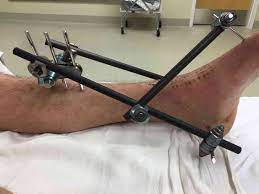External Fixators; External Structure Used To Support Surgical Rods That Are Screwed Into Bones
External fixators are medical devices used to keep fractured
bones stable and in alignment. In an external fixator, screws or metal pins are
placed into the bone through small incisions in the skin and muscle. The screws
and pins are attached to a bar outside the skin. External fixators are can be
adjusted externally to make sure that the bones remain in an optimal position
during the healing process. They provide fracture fixation based on the
principle of splinting. External fixators are often used in severe traumatic
injuries because they allow for rapid stabilization by allowing access to soft
tissues that may also need to be treated.
This is especially important when there is significant
damage to the skin, nerves, muscles, or blood vessels. There are three basic
types of external
fixators; hybrid fixator, ring fixator, and standard uniplanar fixator.
They are designed to stabilize bone and soft tissues, and stabilize infected
Ligamentotaxis, arthrodesis, non-unions, etc. of the bones. Moreover, external
fixators are used to restore limb length, correct bone misalignment, and
protect soft tissues after bone injury. They help to ensure ideal
neutralization, extension, or compression of bone placement while allowing
movement of nearby joints.
External fixators not only aid in the proper placement of
bones but also help reduce muscle atrophy and edema (swelling that is caused by
fluid trapped in your body's tissues) due to total immobilization of a limb.
Thus, with the increasing incidence of fractures around the world, the demand
for external fixators is also increasing with a rapid pace, especially in the
United States. The risk of a fracture increases with age and is greatest in
women. According to the National Osteoporosis Foundation, around 54 million people
in the U.S. have osteoporosis and low bone mass, placing them at increased risk
for osteoporosis.
Around one in two women and up to one in four men age 50 and
older will break a bone due to osteoporosis (a bone disease). This in turn is
expected to increase the demand for external fixators worldwide, especially in
the U.S.




Comments
Post a Comment